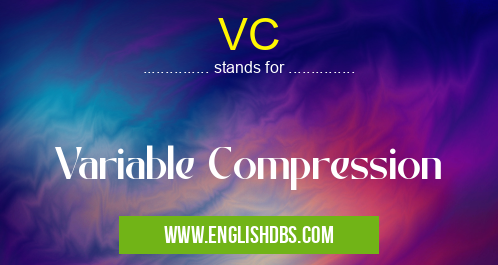What does VC mean in UNCLASSIFIED
VC, or Variable Compression, is a technology used in internal combustion engines to optimize engine efficiency and power output by dynamically adjusting the compression ratio. This is achieved through the use of a movable cylinder head or piston.

VC meaning in Unclassified in Miscellaneous
VC mostly used in an acronym Unclassified in Category Miscellaneous that means Variable Compression
Shorthand: VC,
Full Form: Variable Compression
For more information of "Variable Compression", see the section below.
Functionality
VC works by adjusting the position of the cylinder head or piston during the compression stroke. When higher compression is desired, the cylinder head or piston moves closer to the combustion chamber, increasing the compression ratio and improving fuel efficiency. Conversely, when lower compression is needed, the cylinder head or piston moves further away, decreasing the compression ratio and allowing for higher boost pressure.
Advantages
- Improved fuel efficiency: Higher compression ratios lead to more efficient combustion, reducing fuel consumption.
- Increased power output: Lower compression ratios enable higher boost pressure, resulting in increased engine power.
- Reduced emissions: Optimized combustion minimizes exhaust gas emissions, such as nitrogen oxides and particulate matter.
Applications
VC technology is primarily used in high-performance engines, such as those found in sports cars and luxury vehicles. It is also being explored for use in mass-produced vehicles to improve fuel economy and reduce emissions.
Essential Questions and Answers on Variable Compression in "MISCELLANEOUS»UNFILED"
What is Variable Compression (VC)?
Variable Compression is an engine technology that allows the compression ratio of an engine to be adjusted dynamically while the engine is running. This is achieved by altering the distance between the top of the piston and the cylinder head, which in turn changes the volume of the combustion chamber.
What are the benefits of Variable Compression?
Variable Compression offers several advantages:
- Improved fuel efficiency by optimizing the compression ratio for different driving conditions.
- Increased power and torque by adjusting the compression ratio for performance applications.
- Reduced emissions by optimizing combustion and minimizing knock.
How does Variable Compression work?
Variable Compression typically involves a mechanism that alters the height of the cylinder head or the position of the piston. This can be achieved through the use of hydraulics, electric motors, or other technologies.
Is Variable Compression available on production vehicles?
Yes, Variable Compression is currently available on a few production vehicles, such as the Infiniti QX50 and the Mazda CX-30.
What are the limitations of Variable Compression?
Variable Compression technology is still under development and faces some challenges, including:
- Increased complexity and cost compared to traditional engines.
- Potential for reliability issues.
- Limited availability in production vehicles.
Final Words: VC is an innovative technology that allows internal combustion engines to adapt to changing conditions, optimizing performance and efficiency. It offers the potential for improved fuel economy, increased power, and reduced emissions, making it a promising solution for future automotive propulsion systems.
VC also stands for: |
|
| All stands for VC |
